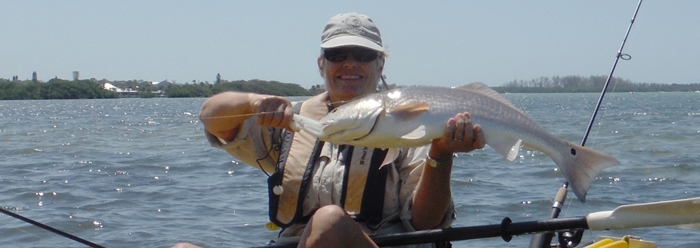As kayak anglers, we need terminal tackle that packs small and will draw strikes from any gamefish we expect to encounter. Jigs work well for us. They come in an endless variety of weights, colors and sizes, and feature many types of skirts ranging from deer hair to durable synthetic fibers and, our favorite, the plastic shad tail design. We almost hate to say it again, but we avoid multiple treble hook lures in the cozy confines of our kayaks. Even the remote chance that we could end up with a thrashing fish hooked on one hook of the treble and our leg hooked to the other treble justifies our reliance on single hook lures.
When Les was a kid growing up in Orlando, jigs were the only lure he carried in his tackle box. For that matter, they were the only lure he could afford on his allowance. They helped catch bass and bluegill from lakes within bicycling distance. Later, as he became more mobile, he found they also worked on shad in the St. Johns River, trolling them in the deep bends near Lemon Bluff. Jigs were also a favorite when he started fishing saltwater and landed snapper, lady fish, pompano, snook and mackerel from beaches on the east coast. On offshore trips, jigs brought grouper and amberjack as well as dolphin to the boat. In short, anything that eats live baitfish or even crustaceans will hit a jig…if the angler makes it look alive yet easy to catch.
Jigs were originally made with lead heads and some fibers attached to hide the hook and give it volume to slow the fall. These days, those jigs still catch fish, but plastic tails have taken over much of the market. Our favorites are the 3” plastic shad tails. Changing colors, designs, sizes or switching to scented or even live baits with a plastic tail is quick and easy compared to tying on a different hair jig for each change. Although colors like “electric chicken” catch fish, we usually try to “match the hatch” with more natural colors. A jig with a chartreuse or pink tip will attract strikes but it’s usually from baitfish, puffers or lizard fish that destroy the tail by biting off that colored tip.
Jig heads vary in design and color. Some styles have the eye positioned back on the head and capture weeds on the retrieve. Our favorite styles have the eye at the front, so weeds picked up by the line mostly slide off under the jig. The CAL jigs are an example of this type. CAL jigs also have glass eyes that gamefish key on during the strike. Weight varies but for the flats where we kayak, a 1/16th ounce or 1/8th ounce size seems to work best. Heavier jigs dig too deep when worked slowly and end up tangled in the grasses during slower retrieves. As for head color the “ancient wisdom” of red on the flats and white on the beaches works well, but Kimball likes chartreuse and out fishes Les regularly. Much heavier jigs are needed for targeting snook in deep channels around bridges or strong tidal currents.
The action of the jig is where the angler gets involved. There are different retrieves used by experienced anglers, but they are all variations of the “hop and drop” presentation that works in most situations. The object is to quickly lift the jig from the bottom and then let it settle back down before the next jerk. Gamefish see this rapid movement when you jerk the bait up from the bottom. It simulates a spooked baitfish. When the jig falls, it looks like an easy, disoriented meal and this is when most strikes occur. Just keep reeling to detect these subtle strikes. If the grass is thick on the flats, an alternate way to rig the jig tail is on a 2/0 wide gap hook with a bullet weight, the way bass anglers rig a worm. The main concept to keep in mind is that you need to move the jig slower when the water is cold. That is why we use 1/16th ounce jigs in the winter. Also, in the winter, a steady retrieve just above the grass on the bottom will draw strikes from lazy fish too cold to chase down anything frisky.
Keep in mind that speckled trout, redfish, and snook are “catch and release” only in our area to help them recover from last year’s devastating red tide event.


